penwith
-
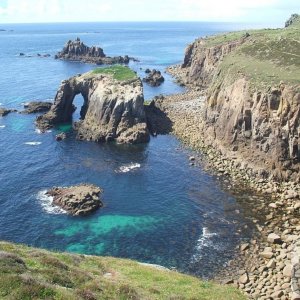
Ennis Dodman, Land's End
This unusual landmark of a holed island with its corrupted name means the Island (Enys) of Grass/Turf (Tonn) of which it probably had enough for a small field when so named but has dwindled in size both as an island and turfed top! behind it you see the rock called 'the Armed Knight' which is...- trepolpen
- Media item
- cliff coast ennis_dodman granite land's_end penwith
- Comments: 2
- Album: PENWITH VOLUME ONE: ROMANTIC, ANCIENT WEST CORNWALL
-
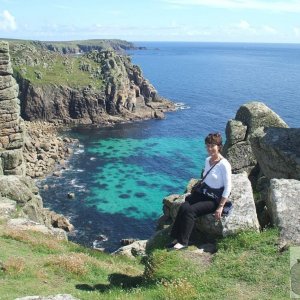
Nearing Mill Bay, near Nanjizel
THis is the stuff that romantic Cornish novels are made of, and the type of coastal scenery that German people see in their televised soap based on Rosamund Pilcher novels and attracts them to Cornwall in droves lately.- trepolpen
- Media item
- cliff coast granite land's_end penwith
- Comments: 0
- Album: PENWITH VOLUME ONE: ROMANTIC, ANCIENT WEST CORNWALL
-
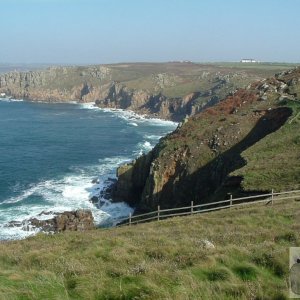
View northwards along the coast from Land's End
An example of a 'zawn' or cleft-like inlet into the cliffs may be noted here. There exists a Cornish word 'sawn' (cleft/gulley) which has some relevance here.- trepolpen
- Media item
- coast land's_end penwith zawn
- Comments: 0
- Album: PENWITH VOLUME ONE: ROMANTIC, ANCIENT WEST CORNWALL
-
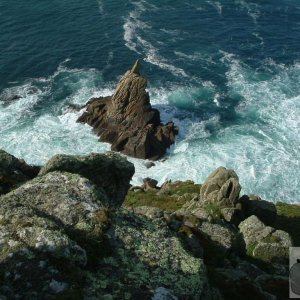
The Irish Lady, Sennen Cove
The legend has it that an Irish boat foundered here and an Irishwoman, one of the passengers on board, clung to this rock for days before sadly, she failed to be rescued. An evocative tale and backed up by this coastal view!- trepolpen
- Media item
- coast irish_lady penwith sennen
- Comments: 4
- Album: PENWITH VOLUME ONE: ROMANTIC, ANCIENT WEST CORNWALL
-

Ancient stones by Gulval Church
- trepolpen
- Media item
- church ludgvan old_stones penwith
- Comments: 0
- Album: PENWITH VOLUME ONE: ROMANTIC, ANCIENT WEST CORNWALL
-
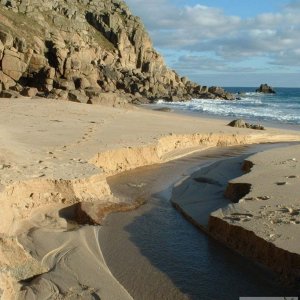
Porth Chapel in January
Such beauty for the beholder here in January on a crisp, clear day. The river is running a different course from its usual one and etching a deep groove in the smooth and barely trodden sand.- trepolpen
- Media item
- coast penwith porth_chapel river
- Comments: 2
- Album: PENWITH VOLUME ONE: ROMANTIC, ANCIENT WEST CORNWALL
-
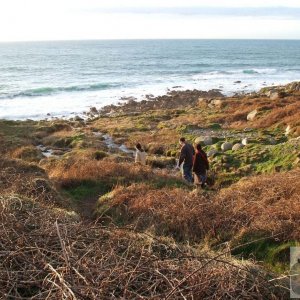
Nanquidno Valley at early evening time.
You certainly get the feeling of Land's End here in this secluded valley that runs right down to where the Channel, the Atlantic Ocean and the Irish Sea join forces beyond the huge, round boulders they mould.- trepolpen
- Media item
- coast nanquidno penwith
- Comments: 0
- Album: PENWITH VOLUME ONE: ROMANTIC, ANCIENT WEST CORNWALL
-
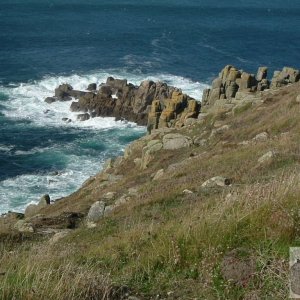
Land's End
Land's End is 'Penn an Wlas' in Cornish as may be seen at the commercial Land's End on its entrance (which copies the Falmouth Custom House). I think this view may show the official end of the land though in past ages, people incorrectly believed Cape Cornwall to be so. For me though, the real...- trepolpen
- Media item
- coast land's_end penwith
- Comments: 1
- Album: PENWITH VOLUME ONE: ROMANTIC, ANCIENT WEST CORNWALL
-
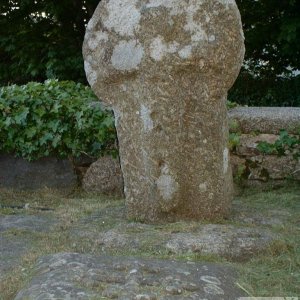
Wheel-headed Wayside Cross in Madron Churchyard
This has been moved several times. As you see, it has been used by local apprentices practising the art of drilling granite with hand tools though this was in the base only as the vertical holes were not shown by Blight in his drawing in 1856 and may be 20th Century damage. The cross has a...- trepolpen
- Media item
- cross madron madron_church penwith
- Comments: 0
- Album: PENWITH VOLUME ONE: ROMANTIC, ANCIENT WEST CORNWALL
-
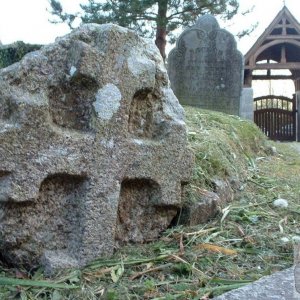
The Churchyard, Madron
This geometric cross does not mark a grave today but may well have done in the past, it is thought.- trepolpen
- Media item
- cross madron madron_church penwith
- Comments: 0
- Album: PENWITH VOLUME ONE: ROMANTIC, ANCIENT WEST CORNWALL
-

Sundial, Madron Church
A timely reminder to us all of our mortality!- trepolpen
- Media item
- madron madron_church penwith sundial
- Comments: 0
- Album: PENWITH VOLUME ONE: ROMANTIC, ANCIENT WEST CORNWALL
-
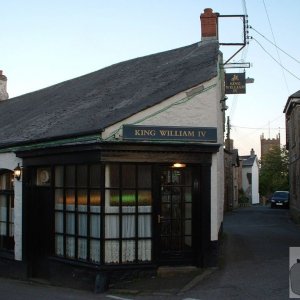
King William IV Inn, Madron
One of the real old pubs of Cornwall, built presumably to drink to the reign (1765-1837) of King William IV, nicknamed the sailor king.- trepolpen
- Media item
- madron penwith pub
- Comments: 0
- Album: PENWITH VOLUME ONE: ROMANTIC, ANCIENT WEST CORNWALL
-

Men Scryfa and Carn Galver
This 'Men Skrifa' or 'Stone [of] Incription' bears one of names of the first Cornish people we know of: 'Rialobrani Cunovali Fili', a Latin inscription showing this to be the monument of Rialobran, son of Cunoval. There is another like this at Bleu Bridge, Gulval. These are probably chieftains...- trepolpen
- Media item
- bosullow carn_galva lower men_scryfa penwith prehistoric
- Comments: 0
- Album: PENWITH VOLUME ONE: ROMANTIC, ANCIENT WEST CORNWALL
-
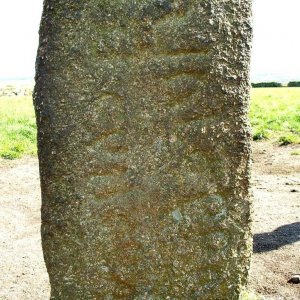
Men Scryfa
This 'Men Skrifa' or 'Stone [of] Incription' bears one of names of the first Cornish people we know of: 'Rialobrani Cunovali Fili', a Latin inscription showing this to be the monument of Rialobran, son of Cunoval. There is another like this at Bleu Bridge, Gulval. These are probably chieftains...- trepolpen
- Media item
- bosullow lower men_scryfa penwith prehistoric
- Comments: 0
- Album: PENWITH VOLUME ONE: ROMANTIC, ANCIENT WEST CORNWALL
-
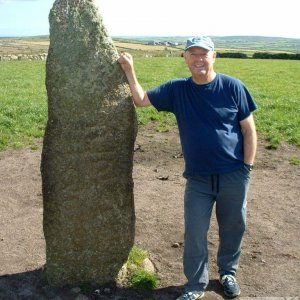
Men Scrifa - from about 500 AD
This 'Men Skrifa' or 'Stone [of] Incription' bears one of names of the first Cornish people we know of: 'Rialobrani Cunovali Fili', a Latin inscription showing this to be the monument of Rialobran, son of Cunoval. There is another like this at Bleu Bridge, Gulval. These are probably chieftains...- trepolpen
- Media item
- bosullow lower men_scryfa penwith prehistoric
- Comments: 6
- Album: PENWITH VOLUME ONE: ROMANTIC, ANCIENT WEST CORNWALL
-
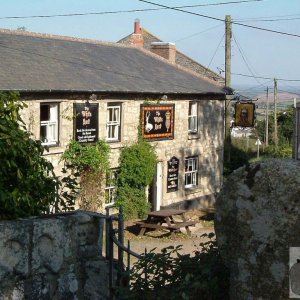
Ludgvan - The White Hart
As seen through the Churchyard entrance. Notice the old cross (right) and the moulded granite on the left.- trepolpen
- Media item
- inn ludgvan penwith pub
- Comments: 1
- Album: PENWITH VOLUME ONE: ROMANTIC, ANCIENT WEST CORNWALL
-
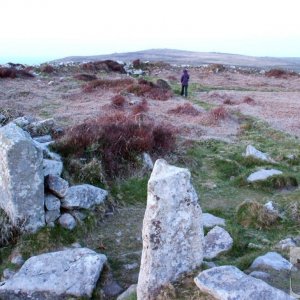
Chun Castle ramparts
Like Lescudjack Castle (which was bigger) and Trencrom (smaller), Chun Castle is a hilltop fortress dating from about 500 BC. It has two stone walls and ditches encircle the summit of the hill. The entrances are staggered to make it harder for the enemy to enter. 'Chun' is a Cornish name derived...- trepolpen
- Media item
- chun_castle penwith prehistoric
- Comments: 1
- Album: PENWITH VOLUME ONE: ROMANTIC, ANCIENT WEST CORNWALL
-
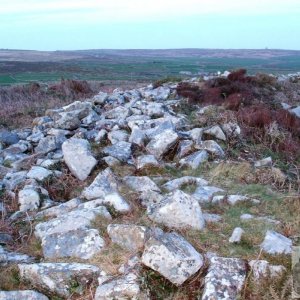
Chun Castle circular inner wall
Like Lescudjack Castle (which was bigger) and Trencrom (smaller), Chun Castle is a hilltop fortress dating from about 500 BC. It has two stone walls and ditches encircle the summit of the hill. The entrances are staggered to make it harder for the enemy to enter. 'Chun' is a Cornish name derived...- trepolpen
- Media item
- chun_castle penwith prehistoric
- Comments: 0
- Album: PENWITH VOLUME ONE: ROMANTIC, ANCIENT WEST CORNWALL
-
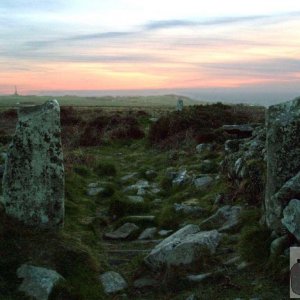
Chun Castle entrance
Like Lescudjack Castle (which was bigger) and Trencrom (smaller), Chun Castle is a hilltop fortress dating from about 500 BC. It has two stone walls and ditches encircle the summit of the hill. The entrances are staggered to make it harder for the enemy to enter. 'Chun' is a Cornish name derived...- trepolpen
- Media item
- chun_castle penwith prehistoric
- Comments: 1
- Album: PENWITH VOLUME ONE: ROMANTIC, ANCIENT WEST CORNWALL
-
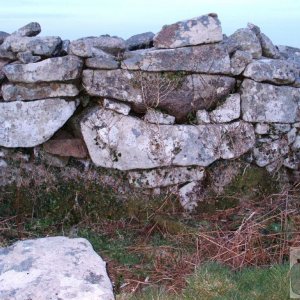
Chun Castle
Like Lescudjack Castle (which was bigger), Chun Castle is a hilltop fortress dating from about 500 BC. It has two stone walls and ditches encircle the summit of the hill. The entrances are staggered to make it harder for the enemy to enter. 'Chun' is a Cornish name derived from 'Chi Woen' or...- trepolpen
- Media item
- chun_castle penwith prehistoric
- Comments: 0
- Album: PENWITH VOLUME ONE: ROMANTIC, ANCIENT WEST CORNWALL

